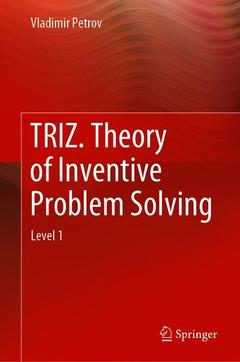Description
TRIZ. Theory of Inventive Problem Solving, 1st ed. 2019
Level 1
Author: Petrov Vladimir
Language: English
221 p. · 15.5x23.5 cm · Hardback
Description
/li>Contents
/li>Biography
/li>Comment
/li>
This introductory book describes the initial (first) level of studying the theory of inventive problem solving (TRIZ) from the series ?TRIZ from A to Z,? and presents the most general methods for solving inventive problems and generating new ideas. Chapter 1 examines traditional technologies for problem solving, based on trial and error. Chapter 2 describes the general concept of TRIZ, while Chapter 3 explains the main notions of ?system? approaches, like system thinking, system and its hierarchy, system effect, emergency, synergetic effect and systematicity. In turn, Chapter 4 describes the notion of ?ideality? and Chapter 5 addresses the notion of resources, their types, and methods for using them. Chapter 6 acquaints readers with one of the most important aspects of TRIZ: contradiction. Chapter 7 describes the inventive principles, while Chapter 8 includes descriptions of the systems of trends proposed by G. Altshuller and the author.
In closing, the author makes recommendations on how to most effectively use TRIZ tools, on how readers can improve their knowledge, skills and habits concerning the use of TRIZ, and on how they can hone their inventive thinking skills. The book also features Appendices that include analyses of selected problems, a list of the main websites related to TRIZ, and lists of examples, problems, illustrations, tables and formulae.Acquaints readers with the main notions and tools of TRIZ
Illustrates the theoretical part with a wealth of examples, problems, and graphics
Provides tasks for individual work at the end of each chapter




